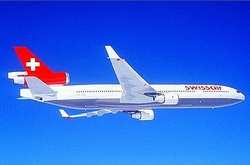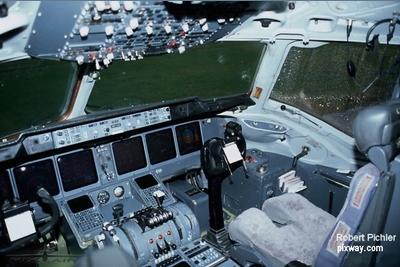Fri, Mar 28, 2003
1998 Crash Cost 229 Lives; On-Board Fire Blamed
 Canada's Transportation Safety Board has released
its final report on the September 2, 1998 crash of a Swissair
MD-11, nicknamed "The UN Shuttle" because of that flight's
popularity among members of that world organization.
Canada's Transportation Safety Board has released
its final report on the September 2, 1998 crash of a Swissair
MD-11, nicknamed "The UN Shuttle" because of that flight's
popularity among members of that world organization.
There were no surprises in the final determination -- the
plane's systems were compromised by an invisible fire, which
quickly incapacitated those systems and some controls -- but the
relief afforded by the release of the report, and the
recommendations contained therein, will have long-lasting
effects.
Even as MD-11s are accelerating toward airplane boneyards,
lessons learned -- in wiring, in circuitry, in composition and
placement of flammable materials -- are being implemented through
the airline industry, and other industries, from architecture to
automotive design.
Here's a synopsis of the causes:

- Aircraft certification standards for material flammability were
inadequate...
- Metallized polyethylene terephthalate (MPET)–type cover
material on the thermal acoustic insulation blankets used in the
aircraft was flammable...
- Once ignited, other types of thermal acoustic insulation cover
materials exhibit flame propagation characteristics similar to
MPET-covered insulation blankets and do not meet the proposed
revised flammability test criteria...
- Silicone elastomeric end caps, hook-and-loop fasteners, foams,
adhesives, and thermal acoustic insulation splicing tapes
contributed to the propagation and intensity of the fire.
- The type of circuit breakers (CB) used in the aircraft were
similar to those in general aircraft use, and were not capable of
protecting against all types of wire arcing events...
- A segment of in-flight entertainment network (IFEN) power
supply unit cable (1-3791) exhibited a region of resolidified
copper on one wire that was caused by an arcing event...
- There were no built-in smoke and fire detection and suppression
devices in the area where the fire started and propagated, nor were
they required by regulation...
- There was a reliance on sight and smell to detect and
differentiate between odour or smoke from different potential
sources. This reliance resulted in the misidentification of the
initial odour...
- There was no integrated in-flight firefighting plan in place
for the accident aircraft, nor was such a plan required by
regulation. Therefore, the aircraft crew did not have procedures or
training directing them to aggressively attempt to locate and
eliminate the source of the smoke...
- ...The fire-related failure of silicone elastomeric end caps
installed on air conditioning ducts resulted in the addition of a
continuous supply of conditioned air that contributed to the
propagation and intensity of the fire.
- The loss of primary flight displays and lack of outside visual
references forced the pilots to be reliant on the standby
instruments for at least some portion of the last minutes of the
flight. In the deteriorating cockpit environment, the positioning
and small size of these instruments would have made it difficult
for the pilots to transition to their use, and to continue to
maintain the proper spatial orientation of the aircraft.
More News
The Industry Continues to be Rocked By Some Questionable Operations Recent investigations and a great deal of data has resulted in ANN’s SportPlane Resource Guide’s rep>[...]
Make Sure You NEVER Miss A New Story From Aero-News Network Do you ever feel like you never see posts from a certain person or page on Facebook or Instagram? Here’s how you c>[...]
Visual Approach Slope Indicator (VASI) An airport lighting facility providing vertical visual approach slope guidance to aircraft during approach to landing by radiating a directio>[...]
Airport Marking Aids Markings used on runway and taxiway surfaces to identify a specific runway, a runway threshold, a centerline, a hold line, etc. A runway should be marked in ac>[...]
Aero Linx: The Skyhawk Association The Skyhawk Association is a non-profit organization founded by former Skyhawk Pilots which is open to anyone with an affinity for the A-4 Skyhaw>[...]
 Unfortunate... ANN/SportPlane Resource Guide Adds To Cautionary Advisories
Unfortunate... ANN/SportPlane Resource Guide Adds To Cautionary Advisories ANN FAQ: Turn On Post Notifications
ANN FAQ: Turn On Post Notifications ANN's Daily Aero-Term (04.29.24): Visual Approach Slope Indicator (VASI)
ANN's Daily Aero-Term (04.29.24): Visual Approach Slope Indicator (VASI) ANN's Daily Aero-Term (04.28.24): Airport Marking Aids
ANN's Daily Aero-Term (04.28.24): Airport Marking Aids ANN's Daily Aero-Linx (04.28.24)
ANN's Daily Aero-Linx (04.28.24)




